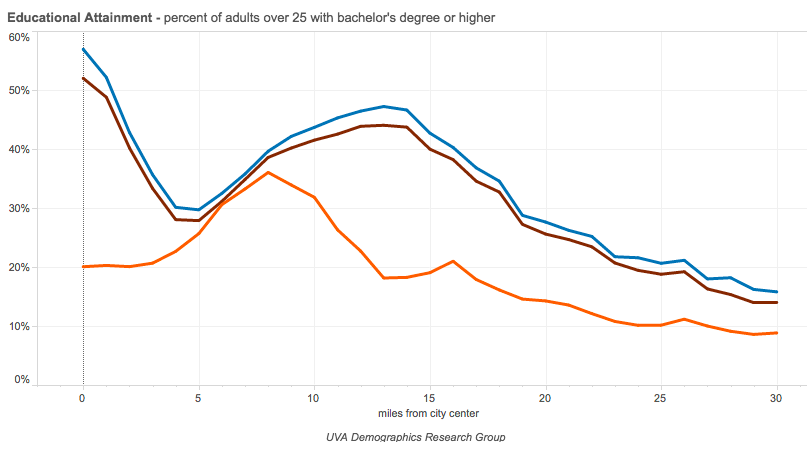What City Observatory did this week
Peaks, Valleys and Donuts: Visualizing cities in cross-section. The University of Virginia’s Demographics Research Group at the Weldon Cooper Center for Public Service has produced a powerful on-line tool for visualizing the spatial patterns of income, poverty, educational attainment and population growth and diversity across the metropolitan area. Their “Changing Shape of American Cities” website lets you compare the distribution of all these variables by distance from the center of the downtown. Its a powerful antidote to binary city v. suburb classifications and imprecise county-level data for showing how cities are structured and what’s driving local and metro growth. Check and see how your city stacks up against others. This chart, for example, shows the strong growth of well educated adults in city centers since 1980. In 1980 (orange) city centers were, on average, less well educated than the rest of the metropolitan area. In recent years (blue and brown lines), the educational attainment rate is highest in the center of the metro area, and educational attainment has a bi-modal distribution.
Must read
1. Just build more housing. Last week’s YIMBY-town was a national convening of many of the nation’s leading community activists fighting for increased housing supply as a way to promote affordability. The conference drew an outspoken critique from local anti-gentrification groups, asking YIMBY’s to pledge to subordinate supply expanding policies to the interests of local neighborhoods. An exasperated Matt Yglesias had some blunt advice for YIMBY activists: Don’t worry so much about placating a fringe of self-styled anti-gentrification activists. Yglesias writes:
As a matter of tactical politics, adding affordable housing advocates to the YIMBY coalition is certainly a good idea. But the level of obsession with this goal seems unwarranted by cold-eyed politics.
At the end of the day, if anti-gentrification activists had that much political clout, we wouldn’t see so much gentrification!
The real issue seems to be that most YIMBY people have left-wing political commitments, and their feelings are sincerely hurt when affordable housing advocates and organizers in communities of color don’t agree with them.
Building more housing everywhere, but especially in high demand cities has huge economic and equity benefits.
2. More on the high cost of parking. Last week, we highlighted a GAO report on the varying cost of building affordable housing in different cities (which ranged from $126,000 in Texas to $326,000 in California). CityLab‘s Kriston Capps wrote a great take on the study, and uncovered a hidden gem we’d missed: GAO gathered data on the cost of parking for affordable housing projects. Based on data from just two states, California and Arizona, (other state’s reporting systems don’t contain this information), cost of building parking for affordable housing added about $56,000 to the cost of a unit. It’s a grim reminder that providing affordable housing for cars takes a big bite out the resources that ought to be providing affordable housing for people.
3. Another look at rent control. In November, California residents will be voting to repeal that state’s Costa-Hawkins law which limits the ability of local governments to impose rent control. While it seems like the merits of rent control have been debated over and over, there are some particularly devilish details, especially in California, where rent control laws interact with other provisions of the California Constitution, as San Francisco blogger Yonathan Randolph explains. In particular, rent regulations have to allow landlords to earn a fair return on their investment, but it appears that this applies only to previous investments, not prospective ones. As a result, there’s no constitutional requirement protecting additional or ongoing investments in property, which is likely to have a chilling effect both on maintenance and on new construction, which could easily reduce both the quality and quantity of the housing stock, worsening California’s housing shortage.


